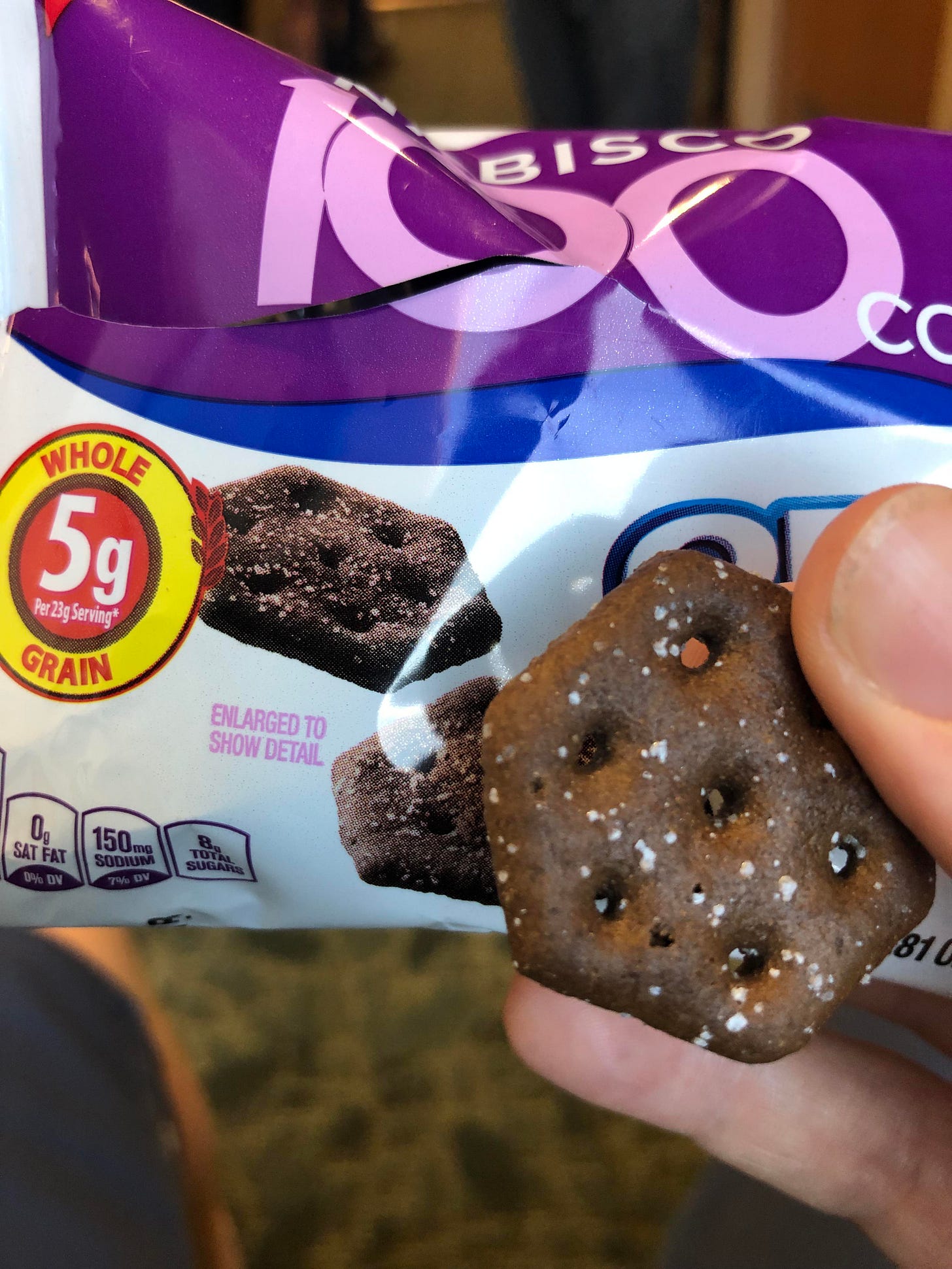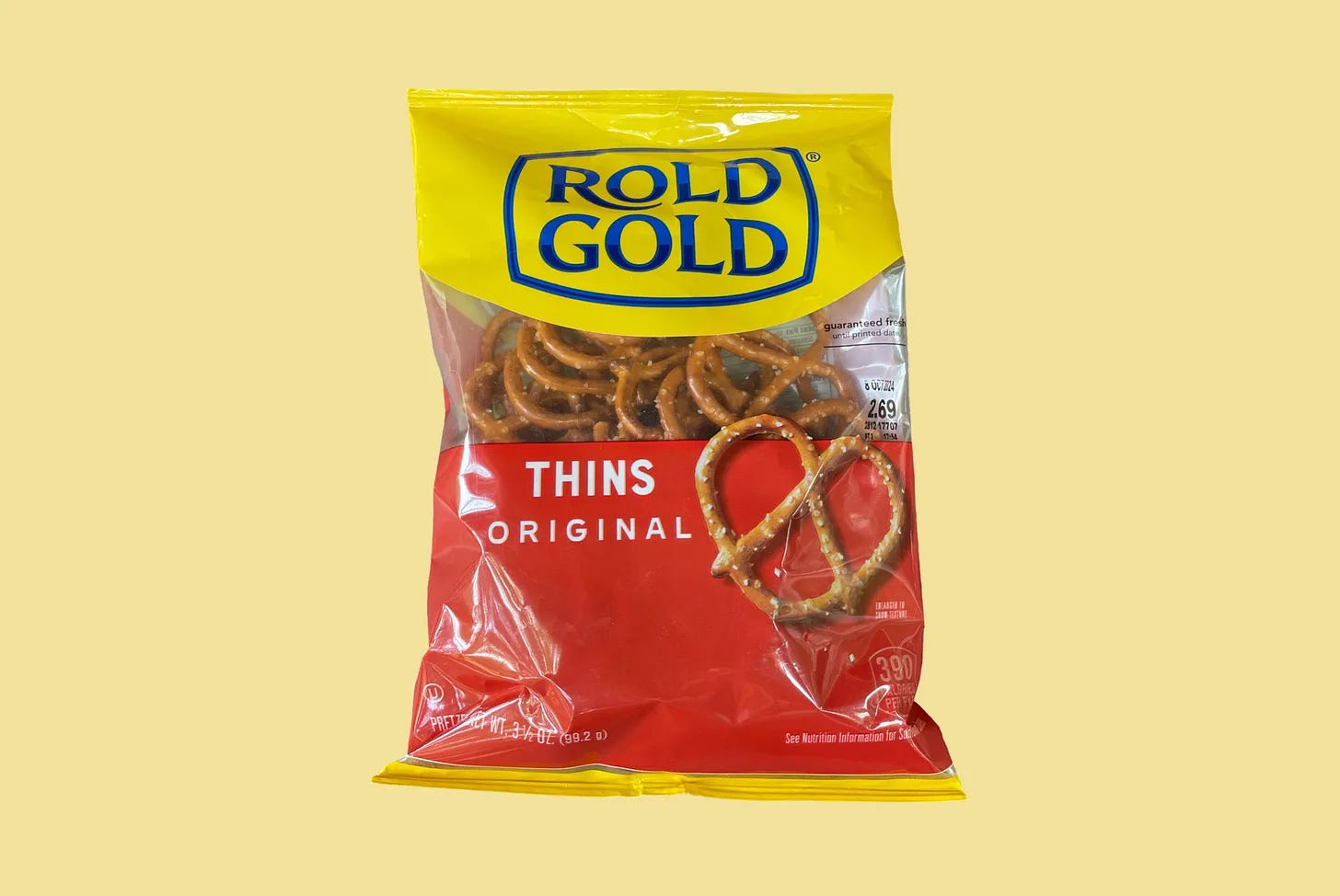Enlarged to Show Texture — or Is It?
A puzzling package design phenomenon, plus a new “Bomp” update!
I was recently eating some Rold Gold pretzels like the ones in the bag shown above. As you can see, the pretzel photo on the right-hand side of the bag is accompanied by a bit of fine print. Let’s zoom in for a closer look:
Ah, yes — the familiar “Enlarged to Show Texture” notice. You’ve probably seen it lots of times before, right? It’s been a staple of food packaging for decades, especially for small-gauge processed foods like breakfast cereals:
Despite doing a lot of Googling, I haven’t been able to determine when this fine-print disclaimer debuted, nor whether it’s the result of a regulatory requirement or just a form of preemptive corporate butt-covering to head off any accusations of misleading packaging. (Anyone know more?) Either way, we all get the gist: “The actual product isn’t really this big or appetizing, so caveat emptor and all that.”
The disclaimer’s wording used to be “Enlarged to Show Detail” (a phrase that had gained so much cultural currency by 1996 that it was used as the title of a rock band documentary), but at some point “Texture” began appearing on some packages instead of “Detail,” with the two terms now coexisting in rough fine-print parity. Personally, I prefer the original “Detail,” but probably just because it came first and got ingrained in my head.
Anyway: I’m not sure why, but when I recently saw the “Enlarged” pretzel image on that Rold Gold bag, I was curious to see just how much the image had been enlarged compared to the actual product. And that’s when I discovered this:
The image on the package hasn’t been enlarged at all! It’s the exact same size as the real pretzels. Why would you add the fine-print disclaimer if it isn’t necessary, or even accurate? (I posed that very question in an email that I sent to the PR folks at Rold Gold’s parent company, Frito-Lay. No response yet, but I’ll post an update if I hear back from them.)
I was feeling pretty pleased with myself for having noticed this, but I soon learned that I was very late to this particular party. The internet (particularly Reddit) is rife with examples of package designs featuring “enlarged” product images that are no bigger — and in some cases are smaller — than the products they’re promoting. Here’s a representative sampling:










I could go on, but you get the idea. A lot of ink is being wasted on disclaimers for “enlarged” images that aren’t actually enlarged!
If anyone has any insights on this puzzling phenomenon (and/or on the origin story behind this type of disclaimer), I’m all ears.
• • • • •
“Bomp” Update
Our story so far: Two weeks ago I wrote about speed bumps, humps, and lumps. About a week after that, I mentioned that my girlfriend, E, had found a Brooklyn street emblazoned with “Bomp” instead of “Bump” (as shown above). And then a few days ago I reported that E and I had been alarmed to encounter a work crew that was in the process of changing the “Bomp” back to “Bump.”
As you may recall, the workers had just painted a black cover-up patch over the top of the “O,” effectively creating a lowercase “u.” They told us that another crew would come on Monday to restore the full capital “U.”
Yesterday was Tuesday, so I biked over to check the status of the lettering repair. Here’s what I found:
Wow! Not only had the full capital “U” not been restored, but the black cover-up paint was already degrading, re-exposing the “O”! Here’s a closer look at that:
The lesson, clearly, is that you can’t keep a good “Bomp” down.
I will continue to monitor this compelling saga as new developments warrant.
Paul Lukas has been obsessing over the inconspicuous for most of his life, and has been writing about those obsessions for more than 30 years. You can contact him here.










I have to admit I wasn’t sure of your rebrand, because I really like uniforms, but I am really really enjoying these posts
A lot of these pictures are on pretty small packages. Some of them are clearly packs that would not be individually for sale, and would therefore need a larger package to contain them. Is it possible that the disclaimer text is just boilerplate so as the size of the package/graphics gets scaled, it's there when it's needed?